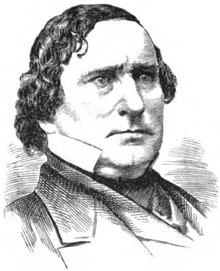George Bliss (Congressman)
George Bliss | |
|---|---|
 | |
| Member of the U.S. House of Representatives from Ohio | |
| In office March 4, 1853 – March 3, 1855 | |
| Preceded by | David K. Cartter |
| Succeeded by | Benjamin F. Leiter |
| Constituency | 18th district |
| In office March 4, 1863 – March 3, 1865 | |
| Preceded by | Harrison G. O. Blake |
| Succeeded by | Martin Welker |
| Constituency | 14th district |
| Personal details | |
| Born | January 1, 1813 Jericho, Vermont, U.S. |
| Died | October 24, 1868 (aged 55) Wooster, Ohio, U.S. |
| Resting place | Oak Hill Cemetery |
| Political party | Democratic |
| Spouse | Sarah J. Fish |
| Children | 5 |
| Alma mater | Granville College |
George Bliss (January 1, 1813 – October 24, 1868) was a member of the United States House of Representatives from Ohio for two non-consecutive terms in the 1850s and 1860s.
Early life[edit]
George Bliss was born on January 1, 1813, in Jericho, Vermont. He graduated from Granville College. He moved to Ohio in 1832 or 1833. He studied law with David Kellogg Cartter. He was admitted to the bar in 1841 and became Cartter's law partner in Akron, Ohio.[1][2][3]
Career[edit]
Bliss was Mayor of Akron in 1850.[2] In 1850, Governor Reuben Wood appointed Bliss as presiding judge of the eighth judicial district, replacing Benjamin Wade and continued in that role until the office was discontinued after a constitutional change.[1][3]
Bliss was elected to the Thirty-third Congress (March 4, 1853 – March 3, 1855) as a Democrat, defeating Free Soiler Darius Lyman. Bliss subsequently withdrew his nomination for re-election in 1855.[1][3] He continued practising law in Wooster, Ohio. He formed a partnership with John McSweeney.[1][3] In 1858, he was principal counsel and attorney in the Oberlin–Wellington Rescue case, assisting George Belden of Canton, the United States District Attorney for the Northern District of Ohio, in the prosecution. Both conspirators were found guilty by the jury in the court of judge Hiram V. Willson, and punished.[4]
Bliss was elected to the Thirty-eighth congress (March 4, 1863 – March 3, 1865) and was an unsuccessful candidate for re-election in 1864. He was a delegate to the Union National Convention at Philadelphia, Pennsylvania in 1866.[1][3]
Death[edit]
Bliss married Sarah J. Fish of Williamstown, New York, and they had one daughter and four sons. After Bliss died, his family moved to Brooklyn, New York.[2][3]
Bliss died in Wooster on October 24, 1868. He was buried in Oak Hill Cemetery.[1][3]
Sources[edit]
- United States Congress. "George Bliss (id: B000559)". Biographical Directory of the United States Congress.
- ^ a b c d e f "Bliss, George". Biographical Directory of the United States Congress. Retrieved 2023-09-08.
- ^ a b c Lane, Samuel A. (1892). Fifty years and over of Akron and Summit County. Akron: Beacon Job Department. p. 551.
- ^ a b c d e f g John Danner, ed. (1904). Old Landmarks of Canton and Stark County, Ohio. p. 261. Retrieved 2023-09-08 – via Archive.org.

- ^ Douglas, Ben (1900). History of the lawyers of Wayne County, Ohio, from 1812 to 1900. Clapper Printing. p. 241.
![]() This article incorporates public domain material from the Biographical Directory of the United States Congress
This article incorporates public domain material from the Biographical Directory of the United States Congress
External links[edit]
 Media related to George Bliss (congressman) at Wikimedia Commons
Media related to George Bliss (congressman) at Wikimedia Commons
- 1813 births
- 1868 deaths
- People from Jericho, Vermont
- Ohio state court judges
- Politicians from Akron, Ohio
- People from Wooster, Ohio
- Democratic Party members of the United States House of Representatives from Ohio
- Mayors of Akron, Ohio
- Denison University alumni
- 19th-century American legislators
- 19th-century American judges

